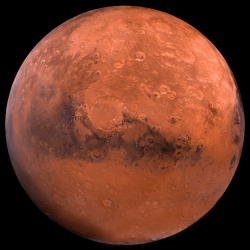
NASA’s Curiosity rover found evidence of liquid water on Mars. Still, this is no life-friendly oasis: The water is hyper-salty, cold, and contained in layers of sludge trapped beneath the soil. Nonetheless, it completes the requirements for Earth-like life. We now know Mars has soil-bound nutrients, a carbon monoxide energy source for hungry microbes, and liquid water.
The scientists behind the water discovery, including Morten Bo Madsen at the Niels Bohr Institute, say that "finding life on Mars still doesn’t look very probable, because it’s simply just too cold and/or too dry" on large swaths of the planet. But it certainly looks at least possible that there could be environmental niches, probably connected to one of these salt-water brines, where life could thrive."
To Gary King, a microbiologist at Louisiana State University who studies life that survives in extreme environments, this presents humanity with an amazing opportunity. We may never find native Martian microbes, and they may, in fact, be long gone. But because the Red Planet’s has that life-friendly trio, the energy sources, nutrients and water, we could grow microbial life there ourselves.
According to King, seeding hand-picked, specially cultivated microbial communities in Mars’ harsh environment is not only possible, but could serve as our very first step in terraforming the planet: transforming our solar neighbor from a desolate hellscape to a thriving environment that could support increasing complex forms of life, and possibly one day even humans. King is clear about the difficulties and caveats such a theoretical project would entail. But that doesn’t stop him from believing it’s possible.
"This could just be my naivete, I don’t think that it’s entirely farfetched to imagine us developing something like a microbial farm on Mars," he says, "and not in something like 200 years, but far sooner."
The concept starts small. Microorganisms that munch on Mars’s natural resources could not only transform the red planet’s soil, but could pump out gasses to bolster the Mars’s embarrassingly thin atmosphere to boot. This is not simply theoretical. Such a process has already been proven already in Earth’s history, King says. We owe all our planet’s atmospheric oxygen to microbe photosynthesis.
